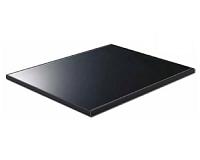 |
Ann Arbor MI (SPX) Apr 25, 2011 A dramatic and surprising magnetic effect of light discovered by University of Michigan researchers could lead to solar power without traditional semiconductor-based solar cells. The researchers found a way to make an "optical battery," said Stephen Rand, a professor in the departments of Electrical Engineering and Computer Science, Physics and Applied Physics. In the process, they overturned a century-old tenet of physics. "You could stare at the equations of motion all day and you will not see this possibility. We've all been taught that this doesn't happen," said Rand, an author of a paper on the work published in the Journal of Applied Physics. "It's a very odd interaction. That's why it's been overlooked for more than 100 years." Light has electric and magnetic components. Until now, scientists thought the effects of the magnetic field were so weak that they could be ignored. What Rand and his colleagues found is that at the right intensity, when light is traveling through a material that does not conduct electricity, the light field can generate magnetic effects that are 100 million times stronger than previously expected. Under these circumstances, the magnetic effects develop strength equivalent to a strong electric effect. "This could lead to a new kind of solar cell without semiconductors and without absorption to produce charge separation," Rand said. "In solar cells, the light goes into a material, gets absorbed and creates heat. Here, we expect to have a very low heat load. Instead of the light being absorbed, energy is stored in the magnetic moment. Intense magnetization can be induced by intense light and then it is ultimately capable of providing a capacitive power source." What makes this possible is a previously undetected brand of "optical rectification," says William Fisher, a doctoral student in applied physics. In traditional optical rectification, light's electric field causes a charge separation, or a pulling apart of the positive and negative charges in a material. This sets up a voltage, similar to that in a battery. This electric effect had previously been detected only in crystalline materials that possessed a certain symmetry. Rand and Fisher found that under the right circumstances and in other types of materials, the light's magnetic field can also create optical rectification. "It turns out that the magnetic field starts curving the electrons into a C-shape and they move forward a little each time," Fisher said. "That C-shape of charge motion generates both an electric dipole and a magnetic dipole. If we can set up many of these in a row in a long fiber, we can make a huge voltage and by extracting that voltage, we can use it as a power source." The light must be shone through a material that does not conduct electricity, such as glass. And it must be focused to an intensity of 10 million watts per square centimeter. Sunlight isn't this intense on its own, but new materials are being sought that would work at lower intensities, Fisher said. "In our most recent paper, we show that incoherent light like sunlight is theoretically almost as effective in producing charge separation as laser light is," Fisher said. This new technique could make solar power cheaper, the researchers say. They predict that with improved materials they could achieve 10 percent efficiency in converting solar power to useable energy. That's equivalent to today's commercial-grade solar cells. "To manufacture modern solar cells, you have to do extensive semiconductor processing," Fisher said. "All we would need are lenses to focus the light and a fiber to guide it. Glass works for both. It's already made in bulk, and it doesn't require as much processing. Transparent ceramics might be even better." In experiments this summer, the researchers will work on harnessing this power with laser light, and then with sunlight. The paper is titled "Optically-induced charge separation and terahertz emission in unbiased dielectrics." The university is pursuing patent protection for the intellectual property.
Share This Article With Planet Earth
Related Links Stephen Rand Lab U-M Sustainability All About Solar Energy at SolarDaily.com
 Solar Frontier Modules Receive UL Certification
Solar Frontier Modules Receive UL CertificationTokyo, Japan (SPX) Apr 21, 2011 Solar Frontier has announced that it has received Underwriters Laboratories (UL) certification for its solar modules sold in the Americas. Products certified include Solar Frontier's new SF130 ~ 150 Watt module series. Solar Frontier's CIS technology (for key ingredients copper, indium and selenium, in addition to gallium and sulfur) offers the highest conversion efficiency of any mass-produced ... read more |
|
| The content herein, unless otherwise known to be public domain, are Copyright 1995-2010 - SpaceDaily. AFP and UPI Wire Stories are copyright Agence France-Presse and United Press International. ESA Portal Reports are copyright European Space Agency. All NASA sourced material is public domain. Additional copyrights may apply in whole or part to other bona fide parties. Advertising does not imply endorsement,agreement or approval of any opinions, statements or information provided by SpaceDaily on any Web page published or hosted by SpaceDaily. Privacy Statement |